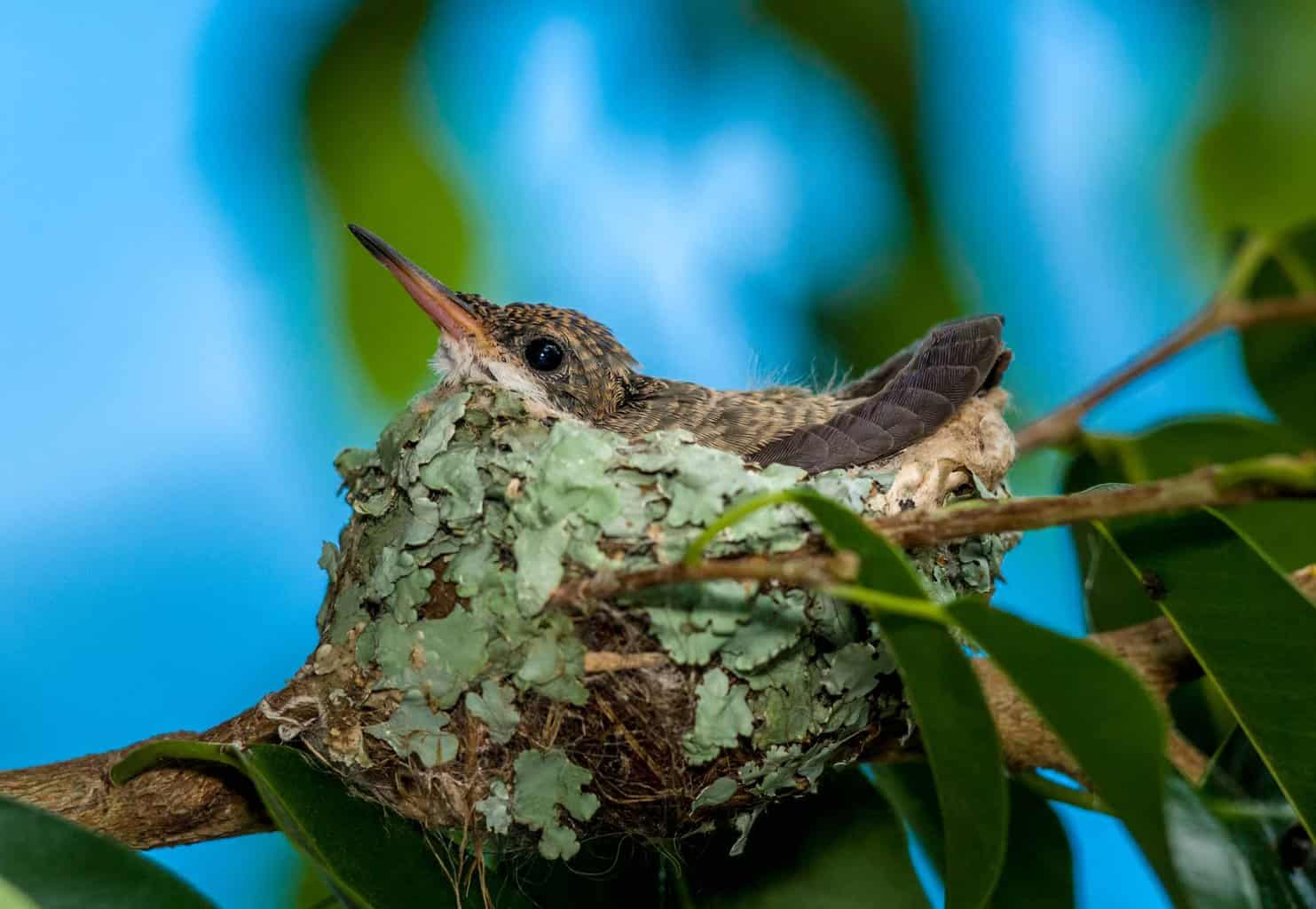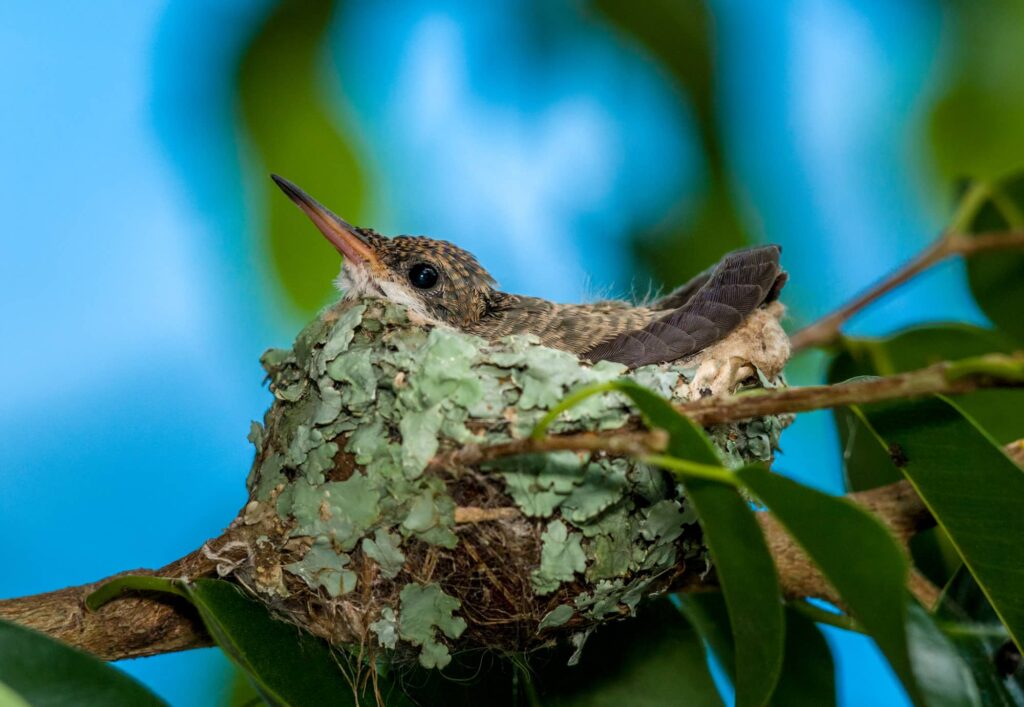Nesting and Brooding Behaviors of Hummingbirds
Where do hummingbirds nest?
It’s a question that has long puzzled avid birdwatchers, as these tiny creatures seem to defy the laws of nature by flying thousands of miles each year in their never-ending search for the perfect place to call home.
But as mysterious and ethereal as they seem, they too need a place to rest and raise a family. Most hummingbirds build their nests safe in the shelter of trees, shrubs, or bushes.
Nesting Sites of Hummingbirds
There are more than 300 species of hummingbirds, and they can be found all across the globe. While their nesting habits vary slightly from region to region, they all share a few key characteristics for finding the perfect spot to raise their young.
In North America, the most common type of hummingbird nest is built in trees or shrubs using plant fibers, spider webs, and other common nesting materials. No matter where they build their nests, hummingbirds are very protective of their young and will fiercely defend their nests from any perceived threat.
If you’re lucky enough to spot a hummingbird nest, be sure to give the parents plenty of space and respect their privacy.
Hummingbird Nest Requirements
First and foremost, hummingbirds need a safe place to nest, away from predators and other hazards. They also need a site that provides ample food and water for the growing hummingbird family. And finally, they need a spot with the right climate—not too hot and not too cold—to ensure their eggs will hatch and the hummingbird chicks will thrive.
What Kind of Trees Do Hummingbirds Nest In?
While some hummingbird species will build their nests in bushes or on the ground, most prefer to nest in trees. The most popular types of trees for nesting hummingbirds are:
- Fir Trees
- Pine Trees
- Palm Trees
- Cottonwood Trees
- Sycamore Trees
If you want to be blessed with nesting hummingbirds in your yard, consider planting your garden with these species and other native trees and shrubs. Backyard birders can also set up a hummingbird feeder to attract these beautiful creatures to your friendly backyard environment.
How To Find A Hummingbird Nest
While it’s not always easy to spot a hummingbird nest, there are a few tell-tale signs that one may be nearby. Look for:
- A cluster of green leaves high up in a tree or bush
- A small, round opening at the top of the nest
- Spider webs or other sticky construction materials clinging to the leaves
If you see any of these signs, there’s a good chance a hummingbird nest is close. But be careful not to disturb the area—remember, these birds are very protective of their young and will defend their nests vigorously if they feel threatened.
The biggest hummingbird nest predator is humans. The best way to enjoy watching hummingbirds is from a distance, preferably with a pair of binoculars. This way, you can admire their beauty without disturbing their natural habitat.
Hummingbird Nest Construction

While the materials they use may vary depending on their location, all hummingbirds build their nests using the same basic technique. First, they find a safe spot to build their nest, usually high up in a tree or bush.
Next, they construct a small platform using spider webs and plant it down. Once the platform is complete, they build the nest walls using more spider silk and plant down, working in a spiral pattern from the bottom up.
Finally, they line the nest with softer materials like feathers or animal fur to create a comfortable place for their eggs. The entire process takes about two weeks to complete.
What Does A Hummingbird Nest Look Like?
While hummingbird nests can vary slightly in size and shape depending on the species, they all share a few key characteristics. Most hummingbird nests are:
- Small
- Round
- Built high up in a tree or bush
- Made from spider webs, fluffy plant material, and other common materials
The average hummingbird nest is about the size of a thimble, but the nests can range in size from smaller than a ping-pong ball to larger than a teacup. Despite their small size, hummingbird nests are quite sturdy and can withstand heavy rains and high winds.
Hummingbird Nesting Behavior
One of the most interesting things about hummingbirds is their nesting behavior. Female hummingbirds do all the work when building the nest and incubating the brood of eggs, while the males take care of guarding the nest and providing food for the growing family.
Once the hummingbird eggs hatch, both parents spend a few hectic weeks feeding the baby hummingbird until it is old enough to fend for itself. This division of labor ensures that the young birds have the best chance of survival.
The Breeding Season & Courtship
The hummingbird breeding season typically spans from late spring to early summer. During this time, male hummingbirds will stake out a territory and defend it fiercely from other males. Once they have established their territory, they will start to court potential mates.
Courtship rituals can vary depending on the species, but they usually involve the male performing a spectacular display of flying feats to impress the female. If the female is impressed, she will mate with the male and then set about building her nest.
Building The Nest
The female bird will weave lightweight materials together to create a cup-shaped nest that’s just big enough for her to fit inside. She will then line the nest with more plant down and soft materials to keep her eggs safe and warm.
Incubating The Eggs
The incubation period for hummingbirds is about two weeks, and during this time, the mother hummingbird will not leave the nest except to feed. Once the eggs hatch, the female will help feed the young birds until they are old enough to fend for themselves.
Caring For Young
Both parents will help care for the hummingbird hatchlings until they are ready to leave the nest or around four weeks. During this time, the parents will feed the baby birds a diet of insects and nectar.
The young birds will grow quickly, and they will be ready to make their first solo flight before long. After they leave the nest, they will be on their own and only see their parents again during the breeding season.
Same Town, New Home
If a hummingbird’s migration and flight behaviors weren’t interesting enough, it might surprise you to learn that hummingbirds return to the same breeding grounds year after year.
Despite returning to the same place after migration, hummingbirds will rarely reuse old nests. But why not? Moving into last season’s nest would save a couple of weeks of hard work, right?
The intricate design of a hummingbird’s nest allows for flexibility as the young grow (hence the spider webs), and a nest stretched by juvenile hummingbirds is too large to keep a clutch of small eggs cozy for incubation.
Wrapping Up
Now that you know all about hummingbird nests, you can watch for these fascinating little birds the next time you’re outdoors.
If you’re a hummingbird lover lucky enough to spot a hummingbird nest, be sure to give the colorful bird its space and admire it from a distance. The Migratory Bird Protection Act makes it illegal to disturb or move these birds’ nests.
These delicate creatures are an important part of our ecosystem, and we should do everything we can to protect them.

